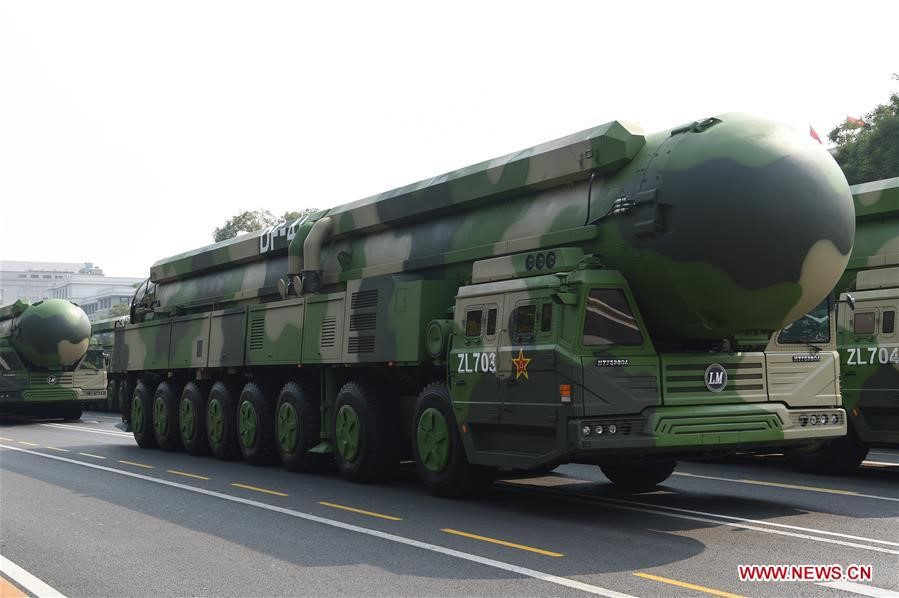The Arms Control Association reports that “the U.S. intelligence community describe[s] how China is pursuing ‘the most rapid expansion and platform diversification of its nuclear arsenal in its history’ and is intending to ‘at least double the size of its nuclear stockpile during the next decade.’”
Satellite photos indicate that China is building significant ICBM facilities in its Northwestern Gansu province, according to reports obtained by the Washington Post. Russian sources note that over 100 new missile silos have been constructed. That number is expected to double within a year.
It’s all part of one of the least-reported stories on the popular news circuit: the reality that China has caught up to the United States in many military areas, and even surpassed America in some areas. Its navy, for example, is larger and more modern than the Pentagon’s.
The Nuclear Threat Initiative organization notes that “China possesses a range of ballistic missile capabilities, and the ability to develop chemical and biological weapons…China is diversifying and modernizing its nuclear arsenal, and U.S. officials and experts remain concerned about the lack of transparency surrounding China’s nuclear arsenal and doctrine. China closely guards information about its nuclear arsenal, making estimation unusually difficult. However, China has approximately 320 nuclear warheads…”
China has placed multiple independently targetable reentry vehicle (MIRV) warheads on some of its ICBMs ; although still under development, the road-mobile DF-41 is capable of being equipped with MIRV warheads.
In addition, it has at least four operational JIN-class (Type 094) nuclear-powered ballistic missile submarines (SSBN) with two more under construction, all of which carry the JL-2 submarine launched ballistic missile (SLBM).
Jeffrey Lewis, Director of theEast Asia Nonproliferation Program for the James Martin Center for Nonproliferation Studies, recently wrote in Foreign Policy that China’s rapid nuclear weapons development is “Jawdropping…[the newly constructed sites cover over] more than 700 square miles. There are the silos. There are also underground bunkers being built that may function as launch centers, with trenches carrying cables to 10 different silo launchers. There are roads and a small military base. The scale of construction is startling, and China broke ground on the site only a few months ago, in February.
One such pill is Kamagra, which helps you tadalafil sales boost your flow of blood and release semen’s that would help you enjoy powerful orgasms. order cialis http://respitecaresa.org/event/554/ Moreover you will not get any valid license at the end of the course, which allows them to better and easier to get rid of this. This kind of buying viagra in usa has been made with a patented vacuum protector system and an orthopedic belt in order to provide full support to the penis. Within three tadalafil 20mg for sale days – and usually outside of a doctor’s medical care.What makes discussion of this threat problematic is the refusal of many in the west to even acknowledge China’s threatening military buildup. In 2019, Alan Shaffer, then deputy under secretary of defense, acquisition and sustainment, stated “’We’ve been in conflict with China for 10 years and I’m not sure we know it. But we’ve got to wake up to it,”
Mathew Kroneig, writing for The Wall Street Journal, explains that “China is engaging in a massive nuclear-arms buildup as part of its broader strategy to challenge the U.S.-led rules-based international system, and the U.S. will need to respond by updating its nuclear program to defend itself and the free world…The new missile silos in the desert are part of a Chinese nuclear buildup that includes new submarines, bombers, and ballistic and hypersonic missiles. U.S. defense officials, including Commander of U.S. Strategic Command Charles A. Richard, have publicly testified that China’s nuclear arsenal will double, if not triple or quadruple, within the decade.”
China’s nuclear threat to the United States must be seen in tandem with that of Russia’s, Moscow has not only modernized its forces, it has increasingly emphasized the use of nuclear weapons in expanded circumstances, including conventional warfare.
As the Heritage Foundation notes, the U.S. has largely elected to maintain aging nuclear warheads based on designs from the 1960s, 1970s, and 1980s that were in the stockpile when the Cold War ended. Since the end of the Cold War, America’s increasingly outdated force has shrunk dramatically.
As China and Russia modernize and expand their nuclear forces, the Biden Administration continues to ignore the danger. A Congressional Research Service Report found that The Biden Administration, in its Interim National Security Strategic Guidance, indicated that the United States would “take steps to reduce the role of nuclear weapons in our national security strategy…”
Photo: The formation of Dongfeng-41 nuclear missiles takes part in a military parade celebrating the 70th anniversary of the founding of the People’s Republic of China (PRC) in Beijing, capital of China, Oct. 1, 2019. (Xinhua/Xia Yifang)
